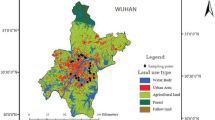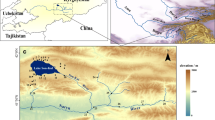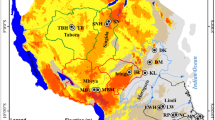Abstract
This study was conducted in an attempt to unravel the concentration level, distribution pattern and potential sources of organochlorine pesticide (OCP) residues in the soil samples from northwestern part of Hyderabad city, India. Soil samples were extracted for pesticide residues using Soxhlet extraction procedure. The sample extracts were analyzed by gas chromatograph coupled with quadruple mass spectrometry (GC–qMS). The results reveal that the δ-HCH, p,p′-DDE, endrin ketone and endosulfan sulfate were most frequently detected, while Heptachlor epoxide and p,p′-DDD were least identified pesticides. The total concentrations of organochlorine pesticides in soils vary from 129 to 1,001 μg kg−1—dry weight. The ratio of (DDD + DDE)/DDT in the soils range from 0.74 to 7.81 which indicates the usage of DDT in the recent past. However, the ratio of DDD/DDE in the soils is <1, which implies that the primary source of p,p′′-DDE was probably from DDT. The average ratios of α-/γ-HCH are lower than 1, which suggest that the lindane has been used recently in the soils of the study area. Also, the total organic carbon shows significant positive correlation with the total concentration of OCPs. This study provides a first time systematic baseline data on OCPs in the soils that could be useful to evaluate the impact on the groundwater as well as risk assessment on human health.






Similar content being viewed by others
References
Aigner EJ, Leone AD, Falconer RL (1998) Concentrations and enantiomeric ratios of organochlorine pesticides in soils from the US Corn Belt. Environ Sci Technol 32(9):1162–1168
Bhanti M, Ajay T (2005) Monitoring of organochlorine pesticide residues in summer and winter vegetables from Agra, India—a case study. Environ Monitor Assess 110:341–346
Bopp RF, Simpson HJ, Trier RM, Kostyk N (1982) Chlorinated hydrocarbons and radionuclide chronologies in sediments of the Hudson River and Estuary. Environ Sci Technol 16(10):666–676
Borisover MD, Graber ER (1997) Specific interaction of organic compounds with soil organic carbon. Chemosphere 34(16):1761–1776
Bossi R, Laesen B, Premazze G (1992) Polychlorinated biphenyl congeners and other chlorinated hydrocarbons in bottom sediment cores of Lake Garden (Italy). Sci Total Environ 121(3):77–93
Dimond JB, Owen RB (1996) Long-term residue of DDT compounds in forest soils in Maine. Environ Pollut 92(2):227–230
Doong RA, Peng CK, Sun YC, Liao PL (2002a) Composition and distribution of organochlorine pesticide residues in surface sediments from the Wu-Shi River estuary. Mar Pollut Bull 45(1–12):246–253
Doong RA, Sun YC, Liao PL, Peng CK, Wu SC (2002b) Distribution and fate of organochlorine pesticide residues in sediments from the selected rivers in Taiwan. Chemosphere 48(2):237–246
Gong ZM, Tao S, Xu FL, Dawson R, Liu WX, Cui YH, Cao J, Wang XJ, Shen WR, Zhang WJ, Qing BP, Sun R (2004) Level and distribution of DDT in surface soils from Tianjin, China. Chemosphere 54:1247–1253
Hites RK, Day HR (1992) Unusual persistence of DDT in some western USA soils. Bull Environ Contam Toxicol 48(2):259–264
IEPN (2006) Country situation on persistent organic pollutants (POP’s) in India. International POPs Elimination Project. http://www.ipen.org/. Accessed 21 Sept 2006
Iwata H, Tanabe S, Sakai N, Tatsukawa RP (1993) Distribution of persistent organochlorines in the oceanic air and surface seawater and the role of ocean on their global transport and fate. Environ Sci Technol 27(6):1080–1098
Iwata H, Tanabe S, Ueda K, Tatsukawa RP (1995) Persistent organochlorine residues in air, water, sediments, and soils from the lake Baikal Region Russia. Environ Sci Technol 29(3):792–801
Jones PW, Freudenthal RI (1978) Carcinogenesis—a comprehensive survey. Raven Press, New York
Kalbitz K, Popp P, Geyer W, Hanschmannb G (1997) Beta-HCH mobilization in polluted wetland soils as influenced by dissolved organic matter. Sci Total Environ 204(12):37–48
King RS, Beaman JR, Whigham DF, Hines AH, Baker ME, Weller DE (2004) Watershed land use is strongly linked to PCBs in while perch in Chesapeake Bay sub estuaries. Environ Sci Technol 38(24):6546–6552
Kong X, Shihua Q, Oramah I, Yuanhai Z (2013) Distribution of organochlorine pesticides in soils of Dashiwei Karst Tiankeng (giant doline) area in South china. Environ Earth Sci. doi:10.1007/s12665-012-2140-y
Muraya KA, Loganathan BG, Kannan K, McCumber Khan S, Lee RF (1997) Organic and organometallic compounds in estuarine sediments from the Gulf of Mexico (1993–1994). Estuaries 20(4):700–709
Oehme M, Mano S (1984) The long range transport of organic pollutants to the Arctic. Fresenius J Anal Chem 319(2):141–146
PAN (2006) Speaking the truth saves lives in the Philippines and India. PAN magazine: pesticide action network North America
Pilidis G, Ioannidou AG, Saraci M, Stalikas C (1996) Determination of organochlorine pesticides and selected heavy metals in Albanian soils. Fresenius Environ Bull 5:551–556
Ramesh A, Tanabe S, Murase H, Subramanian AN, Tatsukawa R (1991) Distribution and behaviour of persistent organochlorine insecticides in paddy soil and sediments in the tropical environment: a case study in South India. Environ Pollut 74(4):293–307
Singh KP, Malik A, Sinha S (2007) Persistent organochlorine pesticide residues in soil and surface water of northern Indo-Gangetic alluvial plains. Environ Monitor Assess 125:47–155. doi:10.1007/s10661-006-9247-0
Stockholm Convention (2009) Measures to reduce or eliminate POPs. Geneva
Stockholm Convention (2010) Stockholm Convention on persistent organic pollutants (POPs), the 9 New POPs under the Stockholm Convention. Geneva
Tanabe S, Iwata H, Tatsukawa R (1994) Global contamination by persistent organochlorine and their ecotoxicological impact on marine mammals. Sci Total Environ 154(2–3):163–177
UNEP (2003) Global report on 2003-regionally based assessment of persistent toxic substances. Geneva, Switzerland
Wang Y, Yiyin X, Shihua Q, Xiaoming L, Xiangheng K, Daoxian Y, Oramah IT (2013) Distribution and potential sources of organochlorine pesticides in the karst soils of a Tiankeng in southwest China. Environ Earth Sci. doi:10.1007/s12665-013-2349-4
Willett KL, Ulrich EM, Hites RA (1998) Differential toxicity and environmental fats of hexachlorocyclohexane isomers. Environ Sci Technol 32(14):2197–2207
Wu WZ, Xu Y, Schramm KW, Kettrup A (1997) Study of sorption, biodegradation and isomerization of HCH in stimulated sediment/water system. Chemosphere 35(9):1887–1894
Acknowledgments
The authors are thankful to Prof. Mrinal K. Sen, Director, CSIR-NGRI, and Hyderabad for his kind permission and encouragement to publish this work. One of the authors (K. Rama Mohan) gratefully acknowledged the financial support by Fast Track Scheme for Young Scientists by Science and Engineering Research Board (SERB) of Department of Science and Technology, Government of India (Grant No. SR/FTP-ES-29-2008).
Author information
Authors and Affiliations
Corresponding author
Rights and permissions
About this article
Cite this article
Kata, M., Srinivasa Rao, S. & Rama Mohan, K. Spatial distribution, ecological risk evaluation and potential sources of organochlorine pesticides from soils in India. Environ Earth Sci 74, 4031–4038 (2015). https://doi.org/10.1007/s12665-014-3189-6
Received:
Accepted:
Published:
Issue Date:
DOI: https://doi.org/10.1007/s12665-014-3189-6




